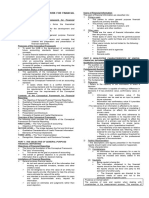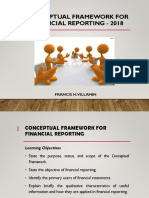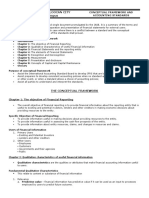0 ratings0% found this document useful (0 votes)
116 viewsChapter 2: The Conceptual Framework: Intermediate Accounting, 11th Edition Kieso, Weygandt, and Warfield
The document summarizes key aspects of Chapter 2 from the textbook Intermediate Accounting. It discusses the objectives, levels, and basic concepts of the conceptual framework for financial reporting. The framework provides objectives for financial reporting, defines elements of financial statements, and establishes criteria for recognition and measurement of those elements. It also identifies relevance and reliability as the primary qualitative characteristics of accounting information.
Uploaded by
KAOSAR AHMEDCopyright
© © All Rights Reserved
Available Formats
Download as PDF, TXT or read online on Scribd
0 ratings0% found this document useful (0 votes)
116 viewsChapter 2: The Conceptual Framework: Intermediate Accounting, 11th Edition Kieso, Weygandt, and Warfield
The document summarizes key aspects of Chapter 2 from the textbook Intermediate Accounting. It discusses the objectives, levels, and basic concepts of the conceptual framework for financial reporting. The framework provides objectives for financial reporting, defines elements of financial statements, and establishes criteria for recognition and measurement of those elements. It also identifies relevance and reliability as the primary qualitative characteristics of accounting information.
Uploaded by
KAOSAR AHMEDCopyright
© © All Rights Reserved
Available Formats
Download as PDF, TXT or read online on Scribd
You are on page 1/ 12
Intermediate Accounting, 11th Edition
Kieso, Weygandt, and Warfield
Chapter 2: The Conceptual
Framework
Objectives of the Conceptual
Framework
• The Framework was to be the
foundation for building a set of
coherent accounting standards and
rules.
• The Framework is to be a reference of
basic accounting theory for solving
emerging practical problems of
reporting.
Overview of the Conceptual
Framework
The Framework has three different
levels,comprised of:
• The first level consists of objectives.
• The second level explains financial elements
and characteristics of information.
• The third level incorporates recognition and
measurement criteria.
Conceptual Framework for
Financial Reporting
Basic Objectives of Financial
Reporting
To provide information:
• about economic resources, the claims on
those resources and changes in them.
• that is useful to those making investment
and credit decisions.
• that is useful to present and future
investors, creditors in assessing future cash
flows.
• to individuals who reasonably understand
business and economic activities.
Hierarchy of Accounting Qualities
Qualitative Characteristics of
Accounting Information
• Primary qualities of accounting information
are relevance and reliability.
• Secondary qualities are comparability and
consistency of reported information.
Primary Characteristic of
Accounting Information:
Relevance
“Relevance of information means information
capable of making a difference in a decision
context.”
Ingredients of relevant information are:
• Timeliness
• Predictive value
• Feedback value
Primary Characteristic of
Accounting Information:
Relevance
Information is reliable when it can be relied on
to represent the true, underlying situation.
The ingredients of reliable information are:
• verifiability
• representational faithfulness
• neutrality (unbiased)
Secondary Characteristics of
Accounting Information
Comparability: the similar measurement and
reporting for different enterprises.
Consistency: application of the same
accounting treatment to similar events by an
enterprise period to period.
Basic Elements of Financial
Statements
• Assets • Comprehensive
• Liabilities Income
• Equity • Revenues
• Investment by • Expenses
Owners • Gains
• Distributions to • Losses
Owners
Recognition and Measurement
Criteria
Basic
Principles Constraints
Assumptions
1. Economic 1. Historical 1. Cost benefit
entity cost 2. Materiality
2. Going 2. Revenue 3. Industry
concern recognition practices
3. Monetary 3. Matching 4. Conservatism
unit 4. Full
4. Periodicity disclosure
You might also like
- Unit Trust Investment Holding Statement As at 26/04/2021: Penyata Pegangan Pelaburan Unit Amanah SetakatNo ratings yetUnit Trust Investment Holding Statement As at 26/04/2021: Penyata Pegangan Pelaburan Unit Amanah Setakat1 page
- Chapter 2: The Conceptual Framework: Intermediate Accounting, 11th Edition Kieso, Weygandt, and WarfieldNo ratings yetChapter 2: The Conceptual Framework: Intermediate Accounting, 11th Edition Kieso, Weygandt, and Warfield17 pages
- Part 1 CONCEPTUAL FRAMEWORK FOR FINANCIAL REPORTINGNo ratings yetPart 1 CONCEPTUAL FRAMEWORK FOR FINANCIAL REPORTING66 pages
- Conceptual Framework Underlying Financial Accounting. Lecture OutlineNo ratings yetConceptual Framework Underlying Financial Accounting. Lecture Outline18 pages
- Conceptual Framework For Financial Accounting-2-1No ratings yetConceptual Framework For Financial Accounting-2-13 pages
- Far410 Chapter 2 Conceptual Framework EditedNo ratings yetFar410 Chapter 2 Conceptual Framework Edited60 pages
- Conceptual Framework for Financial ReportingNo ratings yetConceptual Framework for Financial Reporting11 pages
- Module 1C - ACCCOB2 - Conceptual Framework For Financial Reporting - FHVNo ratings yetModule 1C - ACCCOB2 - Conceptual Framework For Financial Reporting - FHV56 pages
- Summary Notes - Conceptual Framework - Objective of Financial ReportingNo ratings yetSummary Notes - Conceptual Framework - Objective of Financial Reporting5 pages
- UEU Akuntansi Keuangan Menengah 1 Pertemuan 2No ratings yetUEU Akuntansi Keuangan Menengah 1 Pertemuan 235 pages
- Conceptual Framework Underlying Financial ReportingNo ratings yetConceptual Framework Underlying Financial Reporting51 pages
- Conceptual Framework Underlying Financial ReportingNo ratings yetConceptual Framework Underlying Financial Reporting51 pages
- Chapter 2 - Conceptual Framework For Financial ReportingNo ratings yetChapter 2 - Conceptual Framework For Financial Reporting18 pages
- Contemporary Issues in Accounting: Powerpoint Presentation by Matthew Tilling ©2012 John Wiley & Sons Australia LTDNo ratings yetContemporary Issues in Accounting: Powerpoint Presentation by Matthew Tilling ©2012 John Wiley & Sons Australia LTD41 pages
- M1 Handout 4 Conceptual Framework of AccountingNo ratings yetM1 Handout 4 Conceptual Framework of Accounting9 pages
- Intermediate Acc 1 Conceptual Framework, IAS, IfRS, EthicsNo ratings yetIntermediate Acc 1 Conceptual Framework, IAS, IfRS, Ethics12 pages
- Slide Ch02_conceptual Framework for Financial ReportingNo ratings yetSlide Ch02_conceptual Framework for Financial Reporting32 pages
- The IFRS Conceptual Framework Was First Published in 1989 With The Aim of Setting A Theoretical Framework Upon Which The IFRS Standards Are Based OnNo ratings yetThe IFRS Conceptual Framework Was First Published in 1989 With The Aim of Setting A Theoretical Framework Upon Which The IFRS Standards Are Based On4 pages
- Unit 1_THE CONCEPTUAL FRAMEWORK FOR FINANCIAL REPORTINGNo ratings yetUnit 1_THE CONCEPTUAL FRAMEWORK FOR FINANCIAL REPORTING53 pages
- CM2 Revised Conceptual Framework For Financial ReportingNo ratings yetCM2 Revised Conceptual Framework For Financial Reporting14 pages
- Far Vn02 The Revised Conceptual Framework For Financial ReportingNo ratings yetFar Vn02 The Revised Conceptual Framework For Financial Reporting11 pages
- Accounting Frameworks: The Conceptual FrameworkNo ratings yetAccounting Frameworks: The Conceptual Framework4 pages
- The Art and Science of Auditing: Principles, Practices, and InsightsFrom EverandThe Art and Science of Auditing: Principles, Practices, and InsightsNo ratings yet
- Financial Services Firms: Governance, Regulations, Valuations, Mergers, and AcquisitionsFrom EverandFinancial Services Firms: Governance, Regulations, Valuations, Mergers, and AcquisitionsNo ratings yet
- ICAEW ACA Corporate Reporting: Advanced Level Second EditionFrom EverandICAEW ACA Corporate Reporting: Advanced Level Second EditionNo ratings yet
- Republic of The Philippines Securities and Exchange CommissionNo ratings yetRepublic of The Philippines Securities and Exchange Commission4 pages
- Name:S.Srinivasan CPS No:7260169 DOJ:24-06-2014 Treasury/Sub Treasury: PAO (NORTH) DOB: 04-05-1986 Ddo:Asst Commissioner, Civil Supplay & Consumer Protection Dept Details of Contribution in RupeesNo ratings yetName:S.Srinivasan CPS No:7260169 DOJ:24-06-2014 Treasury/Sub Treasury: PAO (NORTH) DOB: 04-05-1986 Ddo:Asst Commissioner, Civil Supplay & Consumer Protection Dept Details of Contribution in Rupees1 page
- Business Combination and Consolidated Financial StatementsNo ratings yetBusiness Combination and Consolidated Financial Statements13 pages
- Sps Mariano Florendo Vs CA, G.R. 101771, December 17, 1996No ratings yetSps Mariano Florendo Vs CA, G.R. 101771, December 17, 19962 pages
- Course Outline BFN 212. Adebayo and ObadeyiNo ratings yetCourse Outline BFN 212. Adebayo and Obadeyi4 pages
- Haryo Setio Utomo: IDR 160,062.37 IDR 0.00No ratings yetHaryo Setio Utomo: IDR 160,062.37 IDR 0.003 pages
- 016 - Express Investments V Bayan TelecommunicationsNo ratings yet016 - Express Investments V Bayan Telecommunications3 pages
- 055 Commissioner of Internal Revenue v. Norton Harrison CompanyNo ratings yet055 Commissioner of Internal Revenue v. Norton Harrison Company2 pages
- Business Plan - WLM Agency - Hamid BouchikhiNo ratings yetBusiness Plan - WLM Agency - Hamid Bouchikhi122 pages
- Scriptie Relation Between Auditor Fees and Earnings ManagementNo ratings yetScriptie Relation Between Auditor Fees and Earnings Management38 pages
- Unit Trust Investment Holding Statement As at 26/04/2021: Penyata Pegangan Pelaburan Unit Amanah SetakatUnit Trust Investment Holding Statement As at 26/04/2021: Penyata Pegangan Pelaburan Unit Amanah Setakat
- Chapter 2: The Conceptual Framework: Intermediate Accounting, 11th Edition Kieso, Weygandt, and WarfieldChapter 2: The Conceptual Framework: Intermediate Accounting, 11th Edition Kieso, Weygandt, and Warfield
- Part 1 CONCEPTUAL FRAMEWORK FOR FINANCIAL REPORTINGPart 1 CONCEPTUAL FRAMEWORK FOR FINANCIAL REPORTING
- Conceptual Framework Underlying Financial Accounting. Lecture OutlineConceptual Framework Underlying Financial Accounting. Lecture Outline
- Module 1C - ACCCOB2 - Conceptual Framework For Financial Reporting - FHVModule 1C - ACCCOB2 - Conceptual Framework For Financial Reporting - FHV
- Summary Notes - Conceptual Framework - Objective of Financial ReportingSummary Notes - Conceptual Framework - Objective of Financial Reporting
- Conceptual Framework Underlying Financial ReportingConceptual Framework Underlying Financial Reporting
- Conceptual Framework Underlying Financial ReportingConceptual Framework Underlying Financial Reporting
- Chapter 2 - Conceptual Framework For Financial ReportingChapter 2 - Conceptual Framework For Financial Reporting
- Contemporary Issues in Accounting: Powerpoint Presentation by Matthew Tilling ©2012 John Wiley & Sons Australia LTDContemporary Issues in Accounting: Powerpoint Presentation by Matthew Tilling ©2012 John Wiley & Sons Australia LTD
- Intermediate Acc 1 Conceptual Framework, IAS, IfRS, EthicsIntermediate Acc 1 Conceptual Framework, IAS, IfRS, Ethics
- Slide Ch02_conceptual Framework for Financial ReportingSlide Ch02_conceptual Framework for Financial Reporting
- The IFRS Conceptual Framework Was First Published in 1989 With The Aim of Setting A Theoretical Framework Upon Which The IFRS Standards Are Based OnThe IFRS Conceptual Framework Was First Published in 1989 With The Aim of Setting A Theoretical Framework Upon Which The IFRS Standards Are Based On
- Unit 1_THE CONCEPTUAL FRAMEWORK FOR FINANCIAL REPORTINGUnit 1_THE CONCEPTUAL FRAMEWORK FOR FINANCIAL REPORTING
- CM2 Revised Conceptual Framework For Financial ReportingCM2 Revised Conceptual Framework For Financial Reporting
- Far Vn02 The Revised Conceptual Framework For Financial ReportingFar Vn02 The Revised Conceptual Framework For Financial Reporting
- The Art and Science of Auditing: Principles, Practices, and InsightsFrom EverandThe Art and Science of Auditing: Principles, Practices, and Insights
- Financial Services Firms: Governance, Regulations, Valuations, Mergers, and AcquisitionsFrom EverandFinancial Services Firms: Governance, Regulations, Valuations, Mergers, and Acquisitions
- ICAEW ACA Corporate Reporting: Advanced Level Second EditionFrom EverandICAEW ACA Corporate Reporting: Advanced Level Second Edition
- Republic of The Philippines Securities and Exchange CommissionRepublic of The Philippines Securities and Exchange Commission
- Name:S.Srinivasan CPS No:7260169 DOJ:24-06-2014 Treasury/Sub Treasury: PAO (NORTH) DOB: 04-05-1986 Ddo:Asst Commissioner, Civil Supplay & Consumer Protection Dept Details of Contribution in RupeesName:S.Srinivasan CPS No:7260169 DOJ:24-06-2014 Treasury/Sub Treasury: PAO (NORTH) DOB: 04-05-1986 Ddo:Asst Commissioner, Civil Supplay & Consumer Protection Dept Details of Contribution in Rupees
- Business Combination and Consolidated Financial StatementsBusiness Combination and Consolidated Financial Statements
- Sps Mariano Florendo Vs CA, G.R. 101771, December 17, 1996Sps Mariano Florendo Vs CA, G.R. 101771, December 17, 1996
- 016 - Express Investments V Bayan Telecommunications016 - Express Investments V Bayan Telecommunications
- 055 Commissioner of Internal Revenue v. Norton Harrison Company055 Commissioner of Internal Revenue v. Norton Harrison Company
- Scriptie Relation Between Auditor Fees and Earnings ManagementScriptie Relation Between Auditor Fees and Earnings Management

























































































